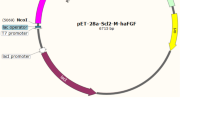Summary
An anti-metastatic polypeptide, bifunctional-domain (Cell I -Hep I) recombinant polypeptide of human fibronectin, was expressedin E. coli and purified. The expression level was found to be about 20%– 30 % of the total cell proteins. In BL21 (DE3)/T7, anE. coli expressing system, lactose can be used as an inducer to substitute IPTG thereby reducing the cost by several hundredfold and it is suitable for the large-scale preparation of recombinant FN polypeptide. Cell I -Hep 1 fragment is an alkaline polypeptide. In BL21(DE3)/T7 expressing system, better isolation was achieved if DEAE-52, instead of CM-52, was used for ion-exchange chromatography. The purified product was obtained after heparin-agarose affinity chromatography following ion-exchange chromatography.
Similar content being viewed by others
References
Kornblihtt A, Umezawa K, Vibe-Pedersen Ket al. Primary structure of human fibronectin: differential splicing may generate at least 10 polypeptides from a single gene. The EMBO J, 1985, 4(7): 1755
Kimizuka F, Taguchi Y, Ohaate Yet al. Production and Characterization of functional domains of human fibronection expressed in Escherichia coli. J Biochem, 1991, 110: 284
Saiki I, Makabe T, Yoneda Jet al. Inhibitory effect of fibronection and its recombinant polypeptides on the adhesion of metastatic melanoma cells to laminin. Jpn J Cancer Res, 1991, 82: 1112
Matsumoto Y, Saiki Y, Makabe Tet al. Inhibitory effect of antimetastatic fusion polypeptide of human fibronectin on tumor cell adhesion to. extracellular matrices. Jpn J Cancer Res, 1991, 82: 1130
Yoneda J, Saiki I, Kobayashi Het al. Inhibitory effect of recombinant fibronectin polypeptides on the adhesion of liver-metastatic lymphoma cells to hepaticsinusoidal endothe-lial cells and tumorinvasion. Jpn J Cancer Res, 1994, 85: 723
Saiki I, Murata J, Makabe Tet al. Inhibition of lung metastasis by synthetic and recombinant fragments of human fibronectin with functional domains. Jpn J Cancer Res, 1990, 81: 1003
Saiki I, Matsumoto Y, Murata Jet al. Recombinant fusion polypeptide with Celland Heparin-binding domains of fibronectin inhibits liver metastasis of L5178Y-ML25 lymphoma cells. Jpn J Cancer Res, 1991, 82: 1120
Feng Zuohua, Zhang Guimei, Li Donget al. Construction of expressing plasmids of recombinant FN polypeptides with bifunctional-domain and the characterization of the products expressed inE. coli. J Tongji Med Univ, 1996, 16(2): 70
Studier F W, Moffatt B A. Use of bacteriophage T7 RNA polymerase to direct selective high-level expression cloned geges. J Mol Biol, 1986, 189: 113
Author information
Authors and Affiliations
Additional information
This project was supported by grants from National Natural Science Foundation of China and Science Foundation of the Ministry of Public Health (No. 39370783).
Rights and permissions
About this article
Cite this article
Guimei, Z., Zuohua, F., Dong, L. et al. Investigation on the purification and expression of cell I — Hep I recombinant FN polypeptide inE. Coli . Journal of Tongji Medical University 16, 134–138 (1996). https://doi.org/10.1007/BF02908792
Received:
Issue Date:
DOI: https://doi.org/10.1007/BF02908792




